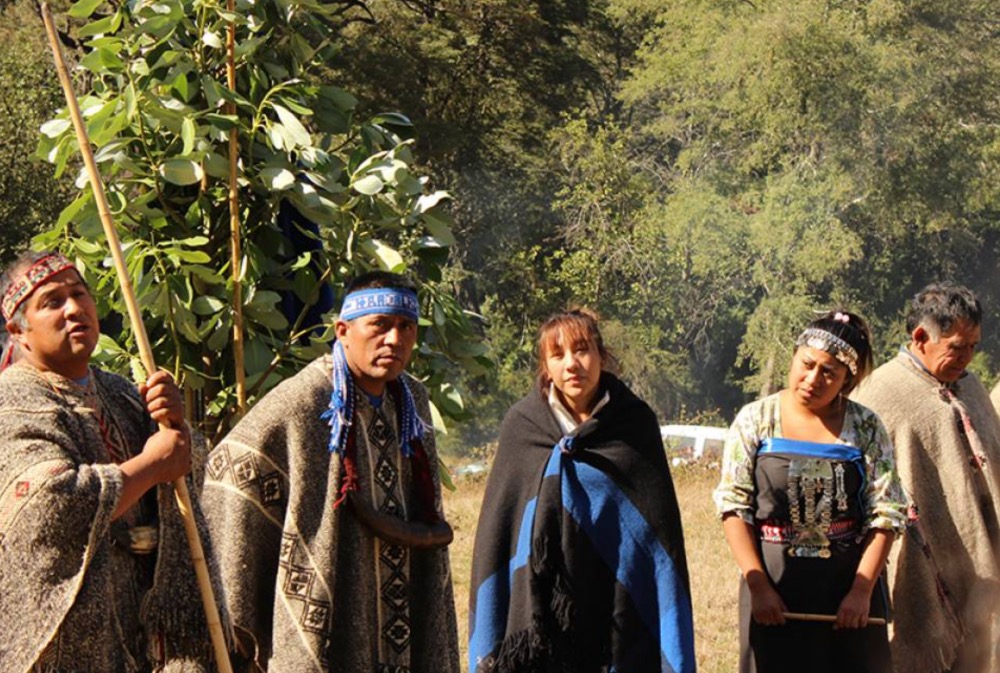Bogota, Colombia
Thomson Reuters Foundation
Watching the US anti-racism protests from a rural town in southern Chile, 19-year-old Belen Curamil, an Indigenous youth leader, has felt a sense of shared experience.
Curamil’s Indigenous peers have endured years of police violence: some have been jailed and others killed in clashes over land rights.

Belen Curamil, third from right, stands next to other Mapuche leaders in Araucania, Chile, on 25th March, 2016. PICTURE: Courtesy of The Goldman Environmental Prize.
“I’ve been watching the news, and believe me, we’re living the same as what’s going on in the US in the way that the police acted against the man [George Floyd] who died,” the teenager told the Thomson Reuters Foundation by phone.
“It makes me angry. I saw the injustice. We’ve been going through this for many years. [Our] people know what repression is,” she said.
The struggles of Indigenous peoples from Australia to Canada have been brought into focus by racial inequality protests sparked by the 25th May death of George Floyd, an unarmed black man, who died in police custody in Minneapolis.
Floyd’s death has not led to demonstrations in Chile but the country’s Indigenous Mapuche people say it reminds them of their decades-long struggle against the state and logging companies they accuse of taking their ancestral land and using undue violence.
Despite Chile being one of South America’s wealthiest and most developed countries, deep social inequalities exist.
Around 30 per cent of Indigenous Chileans live in poverty – almost double the rate compared to the non-Indigenous population.
The Mapuche, which means “Earth People” in the Mapudungun tongue, make up about 10 per cent of Chile’s population of 19 million and mainly work as subsistence farmers in the Araucania region – one the poorest areas of the country.
Mapuche activists have gone on hunger strike, occupied and burned forestry and farming lands and cut off highways to demand territories they say were stolen from them.
Mapuche leaders say that, like black Americans, they have lost a disproportionate number of their own young men to police violence.
One such case was Camilo Catrillanca who was shot dead in 2018 during a police operation that sparked widespread fury among Chileans.
The 24-year-old became a symbol of police brutality and his death triggered the resignation of the country’s police chief.
Still, the struggles of Indigenous people remain unknown to many, according to Karina Riquelme, a Chilean lawyer.
“Every day they [the Mapuche] live in fear that one of their members could end up dead,” said Riquelme, who works with Indigenous groups.
“I don’t think people can imagine but there are tanks, helicopters, and police installations in their communities”.
Holding those responsible to account and getting justice is rare, said opposition lawmaker Emilia Nuyado, Chile’s first Mapuche congresswoman elected in 2018.
“There are cases involving the arrest and deaths of Mapuche leaders that are still in numerous courts, which have had little progress,” she said.
Chile’s interior ministry and attorney general’s office did not respond to requests for comment.
Cases of young Mapuche men killed during confrontations with police have reached the Washington-based Inter-American Commission on Human Rights, which monitors human rights across the Americas.
One case involved Alex Lemun, a 17-year-old Mapuche, who was fatally shot during a police operation in 2002.
The IACHR ruled in 2017 that Lemun’s human rights had been violated by the excessive use of police force, and that there was a pattern of discrimination against Mapuche communities.
In response, Chile admitted responsibility for human rights violations relating to the Lemun case, and pledged to revise its protocols on the use of police force.
For Curamil, the fight for equality and land rights continues.
“As young people, we have to continue to keep rising up and fighting,” Curamil said. “We ourselves have the power to make changes, if we all come together.”






